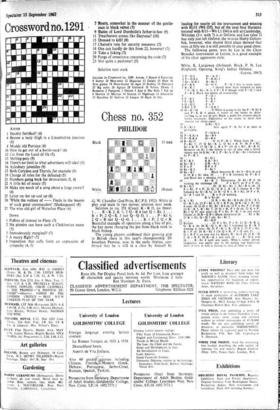Chess no. 352
PHILIDOR
G. W. Chandler (2nd Prize, B.C.P.S. 1952). White to play and mate in two moves; solution next week. Solution to no. 351 (Casa): K - B IL no threat.
1 ... R-K 2„. K 1;2 Q-B 4 (set Q x R). 1 . . . R x P; 2 Q- K 3 (set Q- Q 5). I . . . P- Kt 6; 2 Q x B (set Q -Q 4). 1 . . . K x P; 2 Q x B. Beautiful example of operation along a line of pin, the key move changing the pin from black rook to black bishop.
The young players confirmed their growing grip in British chess in this year's championship. Dr Jonathan Penrose, now in the early thirties, con- firmed that he is still in a class by himself by leading for nearly all the tournament and winning with 8f/11 (W6 D5), but of the next four Hartston (second with 8/1I-W6 LI D4) is still at Cambridge, Whiteley (3= with 7) is at Oxford, and Lee (also 7) has only just left Oxford; the veteran Harry Golom- bek, however, who shared third place showed that even at fifty-six it is still possible to play good chess. The following game, won by Lee in the Clare Benedict tournament at Leysin, is a good example of his clear aggressive style.
White, K. Langeweg (Holland). Black, P. N. Lee (England). Opening, King's Indian Defence.
Leysin, 1967)
1 P - 4 Kt - K B 1 2 P - Q /3 4 P - K Kt 3 3 Kt-QB3 B-Kt 2 4 P - K 4 0 - 0 4 . . . P - Q 3 first is more usual.
5 11 - IC 3 . . 1 should have been tempted to play 5 P- K 5, Kt - K 1; 6 P- 8 4 though with P- la 3 and ' P - B 4. Black has plenty of counterplay.
5...P - Q 3
6 P - B 3 P - K 4
7 P - Q 5 P-B)
8 Q - IQ 2 P x P 9 BPxP P- Q R 3 10 0 - 0 - 0 . . If White is going to try the P - K Kt 4 and P - K K 4 attack it seems to me better to delay castling su as nut to give Black a point for counter-attack before necessary. Experience so far seems to show that chances are about equal.
10 . . . Kt - Q 2 11 K - Kt 1 . . here again P - K Kt 4 at once is preferable.
11 . . . P -QKt 4 P - K Kt 4 Kt- ES 4 13 P-KR4 Q-R4 14 B - Kt 2?. . . If 14 P - R 5. White fears 14 . . .
P - Kt 5; 15 la Kt - K 2, Q Kt x K P. 16 P x Kt, Kt x K P; 17 Q- Q 3, B P! Q x Kt?. B- B 4). However on Kt 2 the bishop is out of play and a better chance was 14 Q Kt - K 2, P - Kt 51 IS Kt - Kt 3 followed by P - R 5. 15 P - 5 KR-Q B1
16 Kt - R 3 Q R - Kt 1 IT 11 x P RPXP 18 ILt - IC 2 P - Kt 5 19 Kt - B 1 . . . Black threatens B - Kt 4 - Q 6 cb and 18 19 B x Kt then 19 .. P x B followed by P - B 5 and Black has a winning attack. 19 . . . Kt. It 5. Threatening 20 Kt - B 6 eh. winning the exchange (20 . . P x Kt??; 21 P x P ch).
20 R - la 1 . . . Or 20 Kt - Kt 3. Kt - B 6 els; 21
P X Kt, P X P; B 2, B- ft 5 (threat B x Kt followed by Q it 6); 23 B - Q B 1, B x Kt; 24 P x B,
Q - R 5 and 25 . R. It X P ch winning.
X Kt eh! 21 K X Kt ... 21 R X Kt, Kt -B 6 ch; 22 K -B 2. Q-11.5 ch;23P-K1 QxlitPcis; 24K-0 3-Kt
4 mate. Or 21 Q x Kt,3 - B 6 eh; 2 .8 2 P x Kt, P P eh: 23 - R I. R.-- Kt 7; Q X R. P x ch; 25 K X P.
Kt x 0 Pl and win,--26 P X Kt, P - K S ch and mate follows or 26 B- Q B 1 (Black threatened 26 . . . Kt X B; 27 R. X Kt, 0- Q 7 eh), Kt - Kt 5. 21 . . . Kt - 11 6!
22 Resigns 22PXKLPxP;23 Q-KB2, - R 6 cb; 24 K- Q 1 It - Kt 7 followed by B- R 5
winning at once. Or 22 P - R 3, R - Q B I; 23 P x Kt. R x P ch; 24 K- Kt 1 (24 Q x R, P x Q and 25 . . . Q x R P is an easy win for Black), R- Kt 6 ch; 25 K- B 2, Q x R P; 26 K.- Q 1 and now 26 . . . R- Q 6 and' 26 . . . B - Kt 4 each win easily. White's rather abrupt resignation was partly due to his having run hopelessly short of time as well as having no idea of what to do.






























 Previous page
Previous page